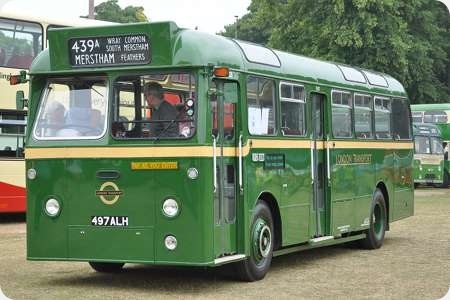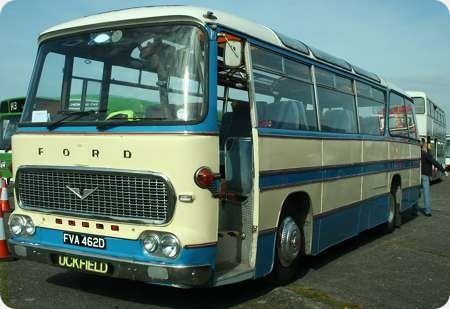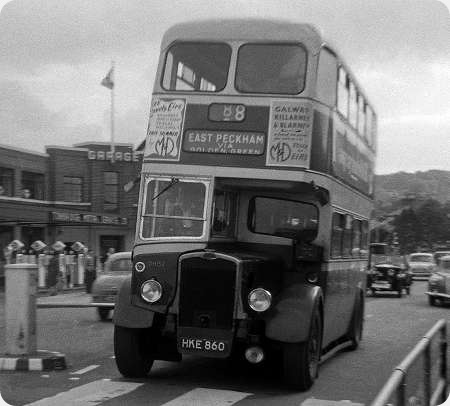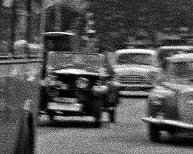London Transport – AEC Reliance – 497 ALH – RW3
London Transport
1960
AEC Reliance 2MU2RA
Willowbrook B42D
497 ALH, AEC Reliance 2MU2RA with Willowbrook B42D body, dates from 1960. She is, of course, better known as seen here in London Transport’s RW3 guise, although she spent some time with other operators – notably Chesterfield with her two sisters. She’s seen at the Alton Rally on 21 July 2013.
Photograph and Copy contributed by Pete Davies
29/03/15 – 17:36
Given the widespread use of this combination within the BET empire, was it just the apparent "not designed in Chiswick" attitude that stopped this type from becoming the successor to the RF in both London Country and Green Line service.
Phil Blinkhorn
29/03/15 – 17:36
This is another example of a manufacturer’s standard type that didn’t last long in London Transport service despite giving good service to many other operators across Britain. Rochdale to name one had some virtually identical vehicles that had full service lives.
Where London Transport’s operating conditions so much different from the rest, particularly in the outposts of the Country area, that they seemed unable to sustain vehicles that ran happily for years with other operators?
Philip Halstead
30/03/15 – 08:04
Phil and Philip,
I suspect you are both right. I’m sure Mr Cox will have something to say on this!!!
Pete Davies
30/03/15 – 08:05
There is already a post of RW1, when in service with Chesterfield Corporation and a very useful post by Roger Cox explaining why it was not popular with London Transport. It’s recorded that the engine/fluid flywheel/gearbox, being mounted in one piece, suffered from overheating problems. Obviously, this was overcome by either LTE or Chesterfield Corp’n, for these vehicles to have had such long subsequent lives. However, removing the unsuitable centre-exit was an expensive option for just three vehicles, hence LTE’s likely disposal, although they could just have been disconnected!
LINK: //www.old-bus-photos.co.uk/?p=584
Chris Hebbron
30/03/15 – 08:06
These buses have been discussed on OBP before – see Chesterfield Corporation – AEC Reliance – 495 ALH – 18. The three RW buses joined the London Transport (Country Buses & Coaches) department at the same time as I did – in August 1960. They were LT’s first experience of dual doorway buses, and drivers strongly disliked the feature. On rural routes, where stopping points were often just hard standing cut beck into the hedgerow at the stop post, the central door opened to reveal an impenetrable barrier of vegetation. They were tried out all round the Country area to a universally stony reception, not just from the operating staff but from the engineers as well. At this time London Transport ran a fleet of totally standardised, bespoke vehicles tailored to the rigid Chiswick/Aldenham maintenance system. LT bus garages did not have "engineers" in the sense understood by Company and Municipal operators. LT employed "fitters". If something went wrong with a vehicle at LT, the offending component was removed and sent to Chiswick, and a fully overhauled part fitted in replacement. The RW buses were London Transport’s first experience of the new breed of AEC wet liner engines, and garages just lacked the knowledge and skills required to remedy the faults that arose in daily operation. The traditional ‘send the part to Chiswick’ mentality couldn’t apply. LT simply capitulated to its absurdly inflexible maintenance system and got rid of the three RWs. However, a virtual carbon copy of the whole sorry saga took place again in 1965 with the Reliance RC class of Green Line coaches. Nevertheless, the ponderous maintenance system still persisted, later showing its deficiencies with the DM/DMS Fleetlines, deemed "unreliable" by LT despite being of a type that ran entirely successfully with everyone else in the land. The MB/MBS/MS/SM types suffered similarly. Strangely, the only exception in this sorry tale proved to be the original eight XF Fleetlines operated by the Country area from 1965. These ran until 1981, proving the soundness of the basic design (i.e. free of LT meddling modifications). They outlasted all the other ex LTE types in LCBS service. The scandalous squandering of public money by London Transport was a national disgrace.
Roger Cox
30/03/15 – 08:06
There are some thoughts here: //www.countrybus.org/RW/RW.htm Overheating is mentioned, together with difficulties with the centre exits in rural locations.
Peter Williamson
30/03/15 – 14:34
I remember these 3 buses coming to Chesterfield for use on one man services however it was common for them to be used as crew buses. I remember this one was no20 I conducted it one day on the Barlow routes.
Ken Wragg
31/03/15 – 06:53
It’s rather surprising they bothered with the centre exit for the country area. Even taking on board all Roger points out, single door vehicles for the country routes, a dual purpose equipped single door version for Green Line and a dual door version for the central area would likely, with any other operator, have been seen as ideal. Instead they spent money and kept the drawing office busy by updating the RFs.
Phil Blinkhorn
31/03/15 – 10:12
Thank you, gents, for your further thoughts on this shambles. As Roger says, it has been discussed at length in the past. It was not just LT who didn’t like the DM/DMS Fleetlines, however. Readers may recall that a fair number came down to Wilts & Dorset and Hampshire Bus. Stagecoach bought Hampshire Bus and decided that the Southampton area was not profitable enough, so they sold it on to Solent Blue Line, along with the allocation of vehicles.
Among that allocation were Fleetlines. The then manager of SBL decided he didn’t want them, and arranged an exchange with the former Ribble "high" Bristol VR fleet at Carlisle. One of my friends was among the SBL drivers on the exchange visit. He told me at the time it was the fastest the Fleetlines had ever moved, so eager were the local drivers to do the exchange.
Following on from that, we had VRs with Cumberland and Ribble fleet names trundling around Southampton for several months, for the legalities to be sorted out. I was told that not a single one of the Fleetlines moved away from Keswick Bus Station until a scrapper removed them, but the appearance of an EFE model in the ‘deregulation’ Hampshire Bus livery but with Carlisle fleet names suggests otherwise.
Pete Davies
31/03/15 – 15:55
10 DMs and 8 RMs went to Cumberland in part exchange for the highbridge VRs in 1987. The DMs retained their Hampshire Bus numbers 1917-1926 and as far as I am aware most if not all received the attractive CMS Cumberland livery of ayers red and oatmeal. They were placed in service in Carlisle and survived until October 1988 when Stagecoach replaced them with new Olympians. There were also 4 ex SYPTE Ailsas involved in the deal which were not popular and only lasted a couple of months or so. I have never seen a picture of one of the Ailsas in service so perhaps these were the buses that languished at Keswick Pete?
Update on those liveries after trawling the web. It seems the DMs entered service in Carlisle in a mix of poppy red(?), Hampshire Bus blue, white and red, and in CMS ayers red. Its a pity EFE didn’t choose the latter! There are also a couple of pics of the Ailsas working so that doesn’t explain the Keswick conundrum either!
Mike Morton
01/04/15 – 06:22
Thank you, Mike. So that’s where the Ailsas went! I did wonder. I have a photo of one of them in HB livery in Southampton. If you’d like one, I’ll send it to Peter and ask him to forward it. It, clearly, isn’t suitable for this site!!!! I see the captcha code is MW49, or is that MW4G – a bit under-powered, perhaps!
Pete Davies
02/04/15 – 06:26
Whatever the merits or otherwise of these Reliances, surely the point is that LT didn’t actually need any more single deck buses at this stage, being full up with RFs. Agreed, the RFs were very heavy and thirsty and perhaps a case could have been made for some replacement by lighter and more fuel efficient buses, but even that seems unlikely.
Was this more a case of a manufacturer trying to interest its customer in something than the customer actually having a need for something new? LT didn’t actually buy any more single deck buses (as opposed to Green Line coaches) until the Merlin/Swift era.
Richard Delahoy
02/04/15 – 06:27
I wonder why LT specified quarter-lights. I see that Chesterfield painted over them.
Geoff Kerr
02/04/15 – 16:51
Peter, would love to see the Ailsa. Much appreciated.
Mike Morton
03/04/15 – 05:36
Chesterfield did not paint over the quarter lights.
Ken Wragg
04/04/15 – 06:36
Must be an optical illusion, Ken. Other photos show them still in use.
Geoff Kerr
10/06/16 – 16:43
In answer to Roger Cox view about the operation of the Reliance class (RW) during their brief but fruitful stay with London Transport over the three years…
It was nothing to do with the servicing of these vehicles at the garages but purely the economics that came out of the research programme.
Many of London Transport country routes in the 1950 and 60s had interworking schedules not like the LT central area where one bus would work a number of different routes during a roster. This provided challenges as some routes such as LTs 383/384 at Hitchin would be in town for a period and then out into to remote countryside.
The routing and operational challenges here were often loadings, terminating agreements, and the remit to go to one person operation where in some instances a conductor was required to facilitate the reversing based on vehicle size.
In addition, LT wanted to increase the capacity of their vehicles and reduce route timings to improve efficiencies (debatable as history shows).
There were initial issues with the running of this type….. Overheating and the reliability of the doors were just two but generally they went well in comparison with the Regal Four (RF) and Regent (RT) double deck types.
LT found quite soon that operation of the slightly wider body in narrow lanes and two the door arrangement proved unpopular with staff and passengers (as Roger highlighted) in country locations when the vehicle was positioned to pick up passengers at the stop…. the centre doors would be out of position for alighting.
Drivers by default would have to double stop to let passengers on and off making the centre doors redundant and increase schedule timings as a result. Councils who had responsibility for the stopping points were not willing to fund widening or a new alighting point without subsidy. LT in the end decided that it would not be feasibly at that time to continue with this arrangement. This is just a potted history of events and there were other political / operational issues besides.
Hope this helps
Colin Rivers (one of the fortunate owners of RW 3)
10/06/16 – 19:35
Some very interesting thoughts there, Colin!
Pete Davies
Quick links to the - Comments Page - Contact Page - Home Page




